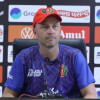How keeping a cool Head paid off

"It's a lot better than seeing the World Cup on the couch at home," said Travis Head as a smile crept across his face.
Head said this on Sunday, soon after he was named the player of the final for his defiant 137 off 120 balls against India that powered Australia to their sixth World Cup title.
Even as a fielder, Head created one of the most memorable moments when he took a stunning catch to dismiss Rohit Sharma, a wicket that flipped the momentum of the match.
However, the man lying on the ground after completing the vital catch could've very easily been lying on his back on some couch in Adelaide watching the final on a screen, had the Australian management not gambled on him.
In fact, when Australia began their campaign on October 8, Head was still in Adelaide, rehabbing his fractured left hand.
Head suffered the injury while batting in an ODI against South Africa in September, which made him unavailable for the first two weeks of the World Cup.
The Australian team had two options, either look for Head's replacement or carry him with the squad and play him when he is fit.
The Aussie team management did neither.
Yes, Head remained a part of the squad, but he didn't have to travel with the team from one city to another with an injured hand as he was allowed to remain at home to complete his rehabilitation.
Australia took a massive gamble on Head as there was always a chance that he would reinjure his hand or might lose his form after the enforced break from competitive cricket.
But the Aussies took this gamble because they realised the importance of having a player like Head in the latter half of the tournament.
The Australian management anticipated that as the tournament progressed, pitches in India would get slower, making it difficult to score runs against the softer ball in the latter part of the innings.
In such conditions, scoring quick runs at the top of the order could prove vital and Head, who has a strike rate in excess of 100 in ODIs, was the ideal guy for the role.
Moreover, his gentle off-spin would give Australia another spin bowling option alongside one genuine spinner in Adam Zampa.
That's why, even when Head was almost 5000 miles away from India, he was still very much a part of Australia's plans.
After missing the first five matches of the tournament, Head finally began his World Cup campaign with a match-winning 67-ball 109 against New Zealand.
In the semifinal against South Africa, he stifled the opposition's momentum by claiming the wickets of Heinrich Klaasen and Marco Jansen in consecutive deliveries.
With the bat, he plundered a 48-ball 62, giving Australia a headstart in the 213–run chase.
Then came the final and Head, once again, was the difference maker.
Head's brilliance in the knockout stage was a direct result of Australia's long-term planning. They knew who were the players they needed to go all the way in the competition and will now fly back home with the biggest prize in ODI cricket as their reward.

 For all latest news, follow The Daily Star's Google News channel.
For all latest news, follow The Daily Star's Google News channel. 









Comments